Navigation marks
Navigation marks help you safely navigate a waterway. Use these marks in combination with your maps and charts to navigate safely.
How to use navigation marks
Navigation marks show you how to travel through a channel or enter a port, and how to avoid hazards.
Each type of mark has a unique combination of colour, shape, topmark and light. You must be able to identify these marks and pass them safely on the correct side.
Use these marks along with your maps and charts to navigate safely.
Lateral marks
Port marks and starboard marks are called lateral marks. They define the sides of a channel or waterway.
Port marks (red) define one side of the channel. They have a can-shaped topmark or buoy. If lit, they display a flashing red light.
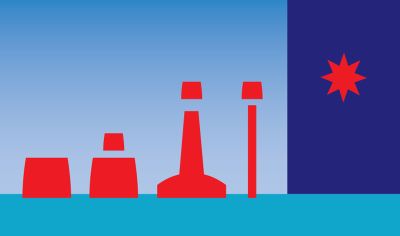
Single starboard marks (green)
When you travel upstream, keep starboard marks on your starboard (right) side.
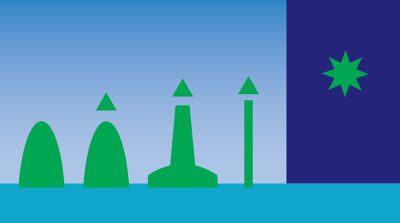
Lateral marks in pairs
When port marks and starboard marks are near each other – in a pair – you should travel between the two.

Single lateral marks
If there's a single mark, the safe side to pass depends on whether you're travelling upstream (away from the sea) or downstream (towards the sea).
Single port marks (red)
When you travel upstream, keep port marks on your port (left) side.
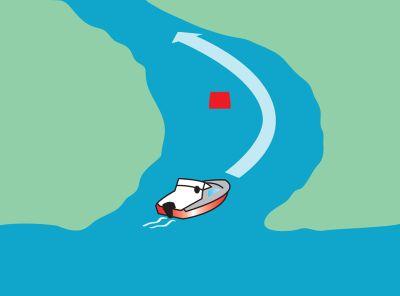
When you travel downstream, keep port marks on your starboard (right) side.

Starboard marks (green) define the other side of the channel. They have a cone (triangle) topmark or buoy. If lit, they display a flashing green light.

When you travel downstream, keep starboard marks on your port (left) side.
Use your vessel's sidelights to help you remember: green to green when going upstream, green to red when seas are ahead.

Cardinal marks
Cardinal marks show the safe side to pass hazards, such as rocks, reefs or shallow water.
For example, a north cardinal mark shows that the safe water is to the north. Specifically, the safe water is in the quadrant between NW (north-west) and NE (north-east) of the north cardinal mark.
The arrangement of the cones and black and yellow bands show which cardinal mark it is – north, south, east or west.
If you remember the coloured bands, you can read a cardinal mark, even if the cones are missing or hard to see from a distance.

North cardinal mark
Pass on the northern side.
Both cones point up, so the black bands are above the yellow bands.
To remember, think of a compass: north is up.
East cardinal mark
Pass on the eastern side.
One cone is pointing up and the other is pointing down, so the black bands are on the top and bottom with yellow in the centre.
To remember, 1 cone up and 1 cone down looks like an egg: 'e' is for egg, 'e' is for east.
South cardinal mark
Pass on the southern side.
Both cones are pointing down so the black band is on the bottom and yellow is at the top.
To remember, think of a compass: south is down.
West cardinal mark
Pass on the western side.
Both cones are pointing in towards each other, so the yellow bands are at the top and bottom with black in the centre.
To remember, both cones pointing in towards each other looks like a wineglass: think 'w' for wine glass, 'w' for west.
Lights on cardinal marks
Cardinal marks have flashing lights so that you can read them at night (between sunset and sunrise) or at times of restricted visibility.
A good way to remember the light flashing pattern is with a clock face:
- N (north): continuous
- E (east): 3 flashes
- S (south): 6 flashes and 1 long flash
- W (west): 9 flashes.
Lead marks
Lead marks (leads) guide you into a port or through sections of a waterway to avoid hazards. They are commonly used for crossing coastal bars and in shipping ports.
Lead marks are made up of 2 marks: one in the foreground and the other behind and above it. They are usually lit at night.
To keep your vessel in safe water:
- line up the 2 marks, one above the other
- travel directly towards or away from the lined-up marks.
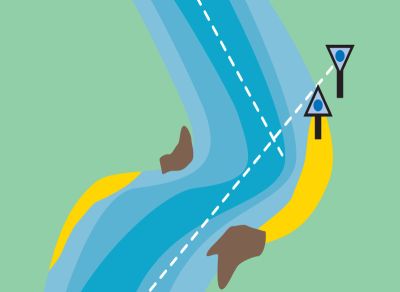
At minor ports, lead marks are usually blue triangular or vertical lights mounted on bright orange or red triangular boards.
In shipping ports, lead marks are usually bigger and more varied. For example, in Port Jackson the lead marks for the eastern channel are white towers with fixed red lights.
All lead marks and sector lights are shown on maps and charts. For your safety, check your chart before travelling on unfamiliar waterways.
Sector lights and directional lights
Similar to lead marks, sector lights guide you into a port or through sections of a waterway. They use coloured lights to show the safe 'sector'.
For example, sector lights on the coast may display 1 colour to vessels coming from the south-east and another colour to vessels coming from the north-east of the light.
Sometimes there are 3 different sectors, each with a different colour.

When a sector light is used at the entrance to a port – for example, Port Macquarie – it’s called a directional light.
A directional light displays red, white and green over a very narrow sector. It can be seen during the day and at night.
When you’re approaching a directional light and you see a:
- red light – you’re too far to the left
- green light – you’re too far to the right
- white light – you’re in safe water and can travel directly towards the light.
Isolated danger marks
An isolated danger mark shows a specific danger – for example, a wreck – surrounded by generally safe water.
The mark is black with a red band in the middle. It has 2 round black topmarks. If lit, it displays a white light flashing in a pattern of 2 flashes.
You can pass an isolated danger mark on any side, but not too close.
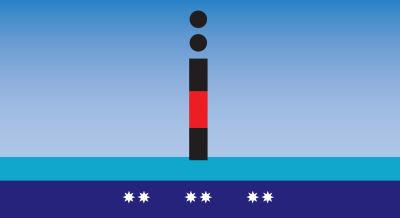
Special marks
These yellow marks show special features or areas, such as:
- tide poles – graduated posts that measure the rise and fall of the tide
- spoil grounds – areas for waste, such as dredged material
- underwater pipes.
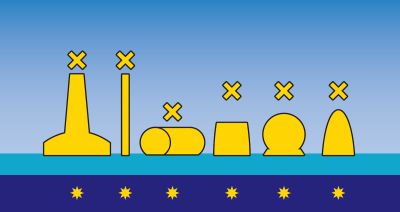
They may have a yellow 'X' topmark. If lit, they display a yellow light which may flash in any pattern.
Special marks may be used as lateral marks. If they have a can-shaped or cone (triangle) buoy, pass them as you would a lateral mark:
- can: port mark
- cone: starboard mark.
Safe water marks
These marks are used to show there is navigable water all around them. They may be used to separate traffic in large shipping channels. They are not common in NSW, but there is one off Bradleys Head on Sydney Harbour.
Safe water marks have red and white vertical stripes. They may be round, pillar-shaped or spar-shaped, and may have a red, round topmark.
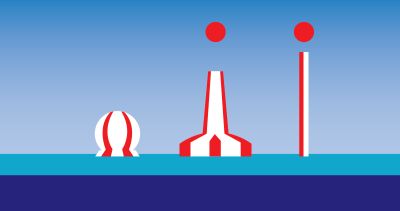
If lit, they display a white flashing light.
Where a safe water mark is used to show the centre line or turning point of a shipping channel, keep the mark on your port (left) side when passing it.
Aquamark minibuoys
Aquamark minibuoys are used in some areas instead of conventional marks.
They are small red, yellow or green buoys, and often have messages on them that you must follow.
You will see 3 shapes in a vertical line, from top to bottom: ball, cone, ball.
At night they are lit, from top to bottom: red, green, red.

Channel blocked or closed signals
These signals are used to show when a:
- bridge span is blocked
- channel is blocked
- port is closed.
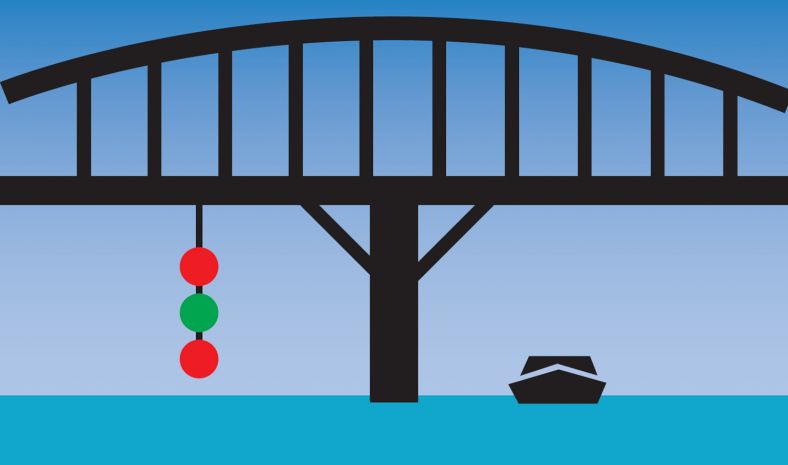
Sample navigation marks and buoys diagram
